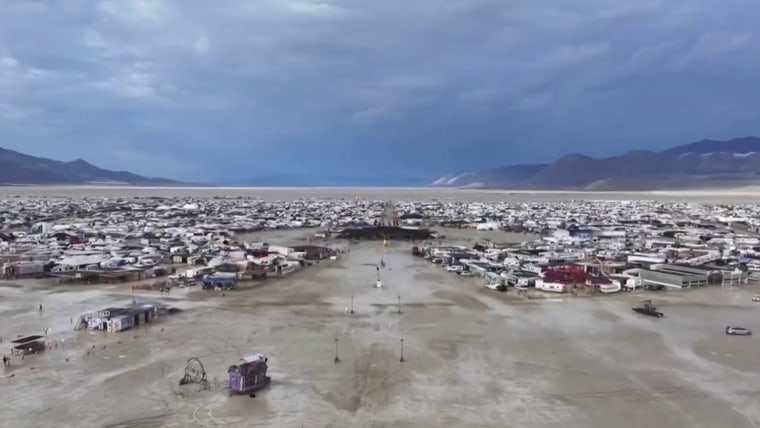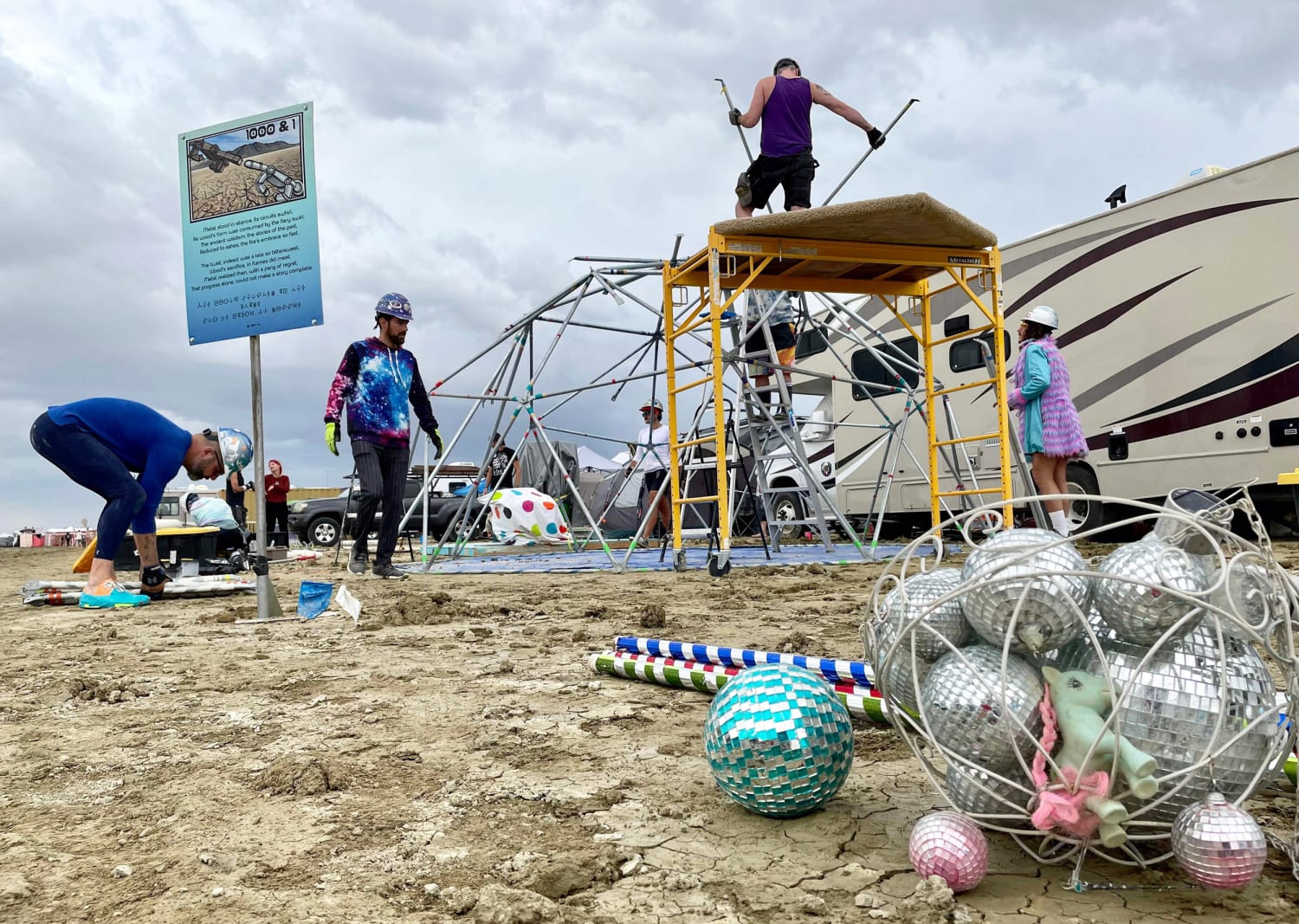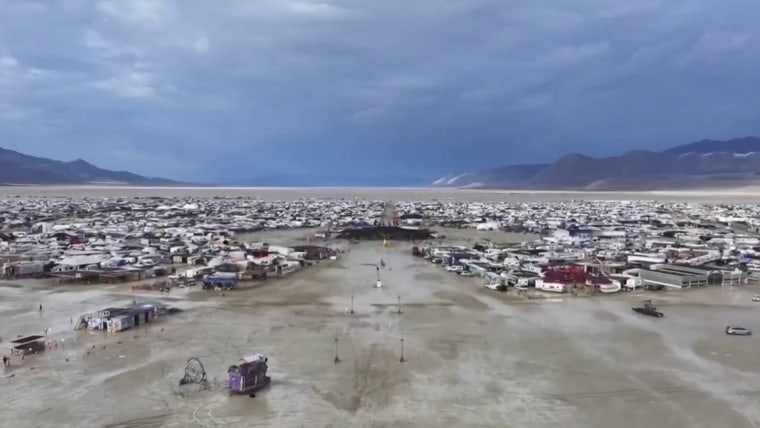Burning Man attendees who abandoned tents, vehicles and waste at the site after a mass exodus from the remote Nevada desert this week began returning to the site Wednesday to begin the herculean task of cleaning up, organizers said.
The annual weekslong cleanup effort that follows the festival could be more challenging this year after torrential rain covered the site and the campgrounds in ankle-deep mud and led some attendees to abandon belongings they’d brought with them to the venue known as Black Rock City.
Festivalgoers who left early because of the storm “are returning to the event site today through Saturday to disassemble their projects, tear down their camps, and remove their possessions,” the Burning Man Project said in a statement Wednesday night.
A team will also begin removing trash from the highways leading to the venue Friday, organizers said. The event is held in a vast expanse of desert referred to as “the playa.”
A special recreation permit that allows the festival to take place in the desert requires organizers “to return the playa to its natural state,” Nevada’s Bureau of Land Management said Thursday.
“After exodus, the Burning Man team has three weeks where they grid out the entire event area and pick up all items and trash,” spokesperson Rita Henderson said in a statement. “In addition, they clean along the side of the county highways leading to and from the event.”
During the first week of October, the bureau and organizers will inspect points around the area to determine whether the cleanup efforts were acceptable, she said, adding that if the bureau finds the cleanup isn’t acceptable, it will schedule time with the organizers to address the issues.
The task of cleaning the site may be taller this year after some attendees fled without having picked up after themselves ahead of a mass exodus Monday following a weekend of heavy rain that flooded roads and shut down access to the festival’s main gate, leaving attendees in a virtual lockdown. A 32-year-old man, Leon Reece of Truckee, California, died at the rain-soaked festival Friday. While the cause and manner of his death are still pending, drug intoxication is suspected, the Washoe County Regional Medical Examiner’s Office said in a statement this week.
Pershing County Sheriff Jerry Allen said Monday that while “there are large amounts of property and trash strewn from the Festival into Reno and points beyond” every year, this year “is a little different in that there are numerous vehicles strewn all throughout the playa for several miles.”
“Some participants were unwilling to wait or use the beaten path to attempt to leave the desert and have had to abandon their vehicles and personal property wherever their vehicle came to rest,” Allen wrote in a statement.
Burning Man organizers said Wednesday that “all but one of the vehicles that were stuck in mud within the Burning Man closure area have been liberated.”
Environmental impact
The environmental effects of Burning Man on the Black Rock Desert playa and its greenhouse gas emissions have concerned environmental groups for years. Climate change activists blockaded the entrance to Burning Man, claiming festival organizers were “greenwashing” the event.
The festival’s carbon footprint is estimated at 100,000 tons of carbon dioxide, according to its sustainability road map. That’s equivalent to emissions from electricity use in more than 19,000 homes for a year, according to the Environmental Protection Agency’s emissions calculator.
The Bureau of Land Management capped festival attendance at 80,000 people in the festival’s most recent permit in 2019 to limit noise, air and light pollution and other harms to species.
Patrick Donnelly, the Great Basin director for the Center for Biological Diversity, said he’d seen social media posts that showed native vegetation like iodine and salt brush getting trampled and driven through as people fled the Black Rock Desert playa. He was also concerned that festival traffic would disrupt rare species of branchiopods that live on the playa, hatch when it rains and feed migratory birds.
After previous Burning Man events, one study found some species had 50% fewer eggs in parts of the playa used for the festival.
But the festival occupies only about 5% to 10% of the playa, Donnelly said, so impacts aren’t widespread.
Donnelly said he wasn’t particularly concerned about the trash festival attendees left behind. He said he drove around the playa about two weeks after last year’s Burning Man looking for trash and other evidence of its impact.
“I was looking for the evidence, and I did not find it. I think they have a pretty good track record of cleaning up after themselves and fulfilling the promises they’ve made to BLM. It’s my hope they’ll continue to do so and clean up all that stuff,” Donnelly said.
Donnelly said he thought Burning Man was a target for criticism because of its rich attendees and “tech bro” culture but added that “nobody has a zero-impact vacation.” He hopes the newfound attention for the Black Rock Desert playa will spark more interest in conservation efforts.
“Most of the outrage on this is people wanting to dunk on Burning Man, but it would be nice if some of this was general enthusiasm for the protection of public lands in Nevada,” Donnelly said, adding that he viewed mining as a greater danger to Nevada’s public lands.
‘Leaving no trace’
As he was preparing to pack up and leave the area, longtime Burning Man attendee Terry Gault said it was “not surprising to hear that there was trash left behind.”
Gault said that wasn’t the case near his camp, which was surrounded by “veteran burners.”
“So for those people who left trash behind, those aren’t real burners,” he said. “They probably shouldn’t be out here anyway.”
In its statement, festival organizers reminded attendees that “leaving no trace” behind when they leave is a core principle of the community.
“All participants are expected to pack out everything they brought in and clean their camp space before leaving the city,” the statement said.
Dr. Brad McKay, an author who said it was his sixth time attending the festival, said that the heavy rain was “unprecedented” and that “many camps that were there were just not prepared for this to happen. There was just a lot of chaos, a lot of confusion and a lot of people trying to survive in very adverse conditions very quickly.”
“A few people did start to panic and get into their vehicles and then just got stuck in the mud and weren’t able to leave whatsoever and had to abandon the vehicles,” he said.
McKay said he worried about bicycles, tents and other garbage abandoned in the area where all of the thick mud made it difficult to see the trash left behind.
“We did the best job that we could,” he said, referring to his camp of 22 people. But others left in a hurry.
“It’s very difficult to leave no trace when you’re trying to leave in a hurry in a horrible environment,” he said.
Source: | This article originally belongs to Nbcnews.com










